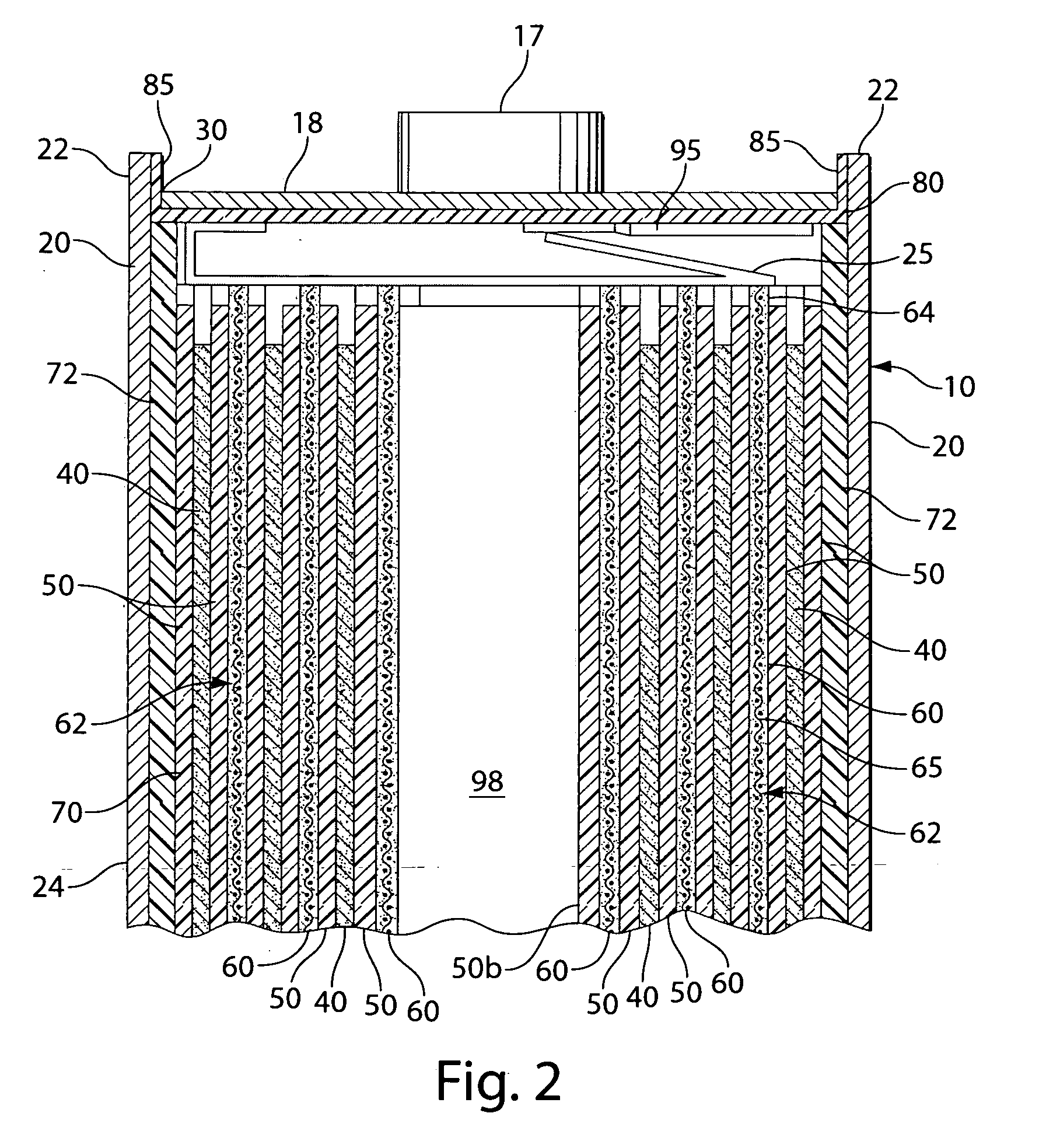[0021]The invention is directed to lithium primary cells wherein the anode comprises
lithium metal. The lithium may be alloyed with small amounts of other
metal, for example aluminum, which typically comprises less than about 1 or 2 wt. % of the lithium
alloy but may be as high as 5 wt % of the lithium. The lithium which forms the anode active material, is preferably in the form of a thin foil. The
cell has a cathode comprising the cathode active material iron disulfide (FeS2), commonly known as “
pyrite”. The cathode may also include another coactive material, preferably
iron sulfide (FeS) coactive material which is compatible with FeS2. Each cathode coactive material must be dischargeable, that is, must participate in useful electrochemical reaction in order to produce useful electrical energy when the
cell is used in normal service. By compatible cathode coactive material is meant that it does not react directly with FeS2 or other coactive materials in direct oxidation-reduction or other reaction, thus losing all or a substantial amount of its electrochemical capacity. If a coactive material is added to the FeS2 cathode mixture it should be stable in the
electrolyte and not react with any of the cathode additives or cathode
current collector or any other of the cell components. All of the cathode coactive materials should have same or similar OCV (
open circuit voltage) within about 10 percent. The OCV of each cathode coactive material against the lithium anode desirably should be between about 1.7 and 1.8 volts so that it is closely compatible with FeS2, which has an OCV (fresh) of about 1.75
volt. In the lithium cell the cathode containing FeS2 and a coactive material should exhibit a similar load
voltage profile as the same cell with only FeS2 as cathode active material (within about 10 percent) when the cell is discharged against the same load. The
iron sulfide (FeS) has a specific theoretical capacity of 609.8 mAmp-hr /
gram, which is lower than the specific theoretical capacity of FeS2 which is 893.6 mAmp-hr /
gram. However, as indicated in commonly assigned U.S.
patent application Ser. No. 12 / 148,030, the addition of FeS to the FeS2 cathode may improve the
overall efficiency of
discharge of the cathode particularly at
high rate discharge conditions.
[0045]In an aspect of the invention the cathode slurry employing the above indicated
hydronaphthalene solvents is prepared and coated onto the substrate, typically a sheet of aluminum, to form the wet cathode composite sheeting as above stated. The cathode composite sheeting is then passed through
drying oven preferably employing forced hot air as the
drying medium. Preferably the oven has two or more separate zones therein wherein each zone is maintained at a progressively higher temperature in the direction of passage of the wet cathode composite sheeting. The heated air passing through the oven is typically between about 75 and 140° C. Preferably the oven has three heating zones. The first zone is maintained, desirably at a temperature between about 60 and 80° C., typically at about 75° C., the second zone may be maintained at a temperature between about 75 and 105° C., typically at about 95° C., and the third zone may be maintained at a temperature between about 130 and 140° C., typically at about 135° C. The total drying
residence time of the wet cathode composite sheet passing through such three zone oven may typically be between about 2.3 and 3.8 minutes. The dry cathode
coating on the substrate may then be subjected to
calendering to compress the coating thickness. If the dry cathode composite sheeting is to be used at part of a wound
electrode assembly, for example, for
insertion into a cylindrical housing, it is preferred to prepare the cathode composite sheeting with a cathode coating on each side of the substrate. In this latter case, the final dry cathode composite sheeting may have a
total thickness typically between about 0.170 and 0.186 mm. A desirable substrate may be of aluminum having a thickness typically of between about 0.015 and 0.040 mm. The cathode composite sheeting produced in this manner using the above indicated
hydronaphthalene solvents and a drying protocol results in a dry cathode coating which resists
cracking. Also the preferred solvents (1,2,3,4-tetrahydronaphthalene or decahydronaphthalene) in addition to being
extremely good solvents for the
styrene-
ethylene / butylenes-styrene block
copolymer binder, thus forming a good binder / solvent solution. The binder / solvent solution appears also to have strong surface affinity for the FeS2 (or FeS2 and FeS particles). This prevents any prolonged
direct exposure of the FeS2 (or FeS2 plus FeS particles) with the drying air or any
moisture contained therein and thus reduces the chance of acidic contaminants, such as
sulfuric acid forming on the surface of these particles during the drying process.
 Login to View More
Login to View More 


